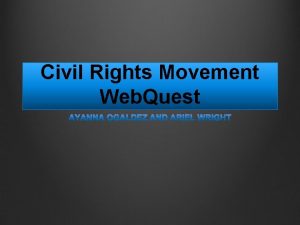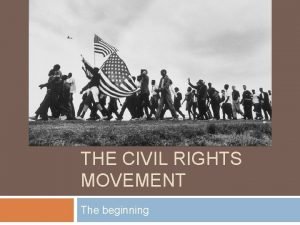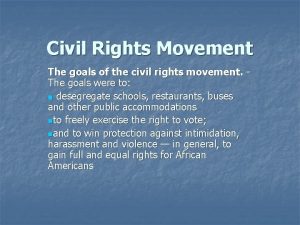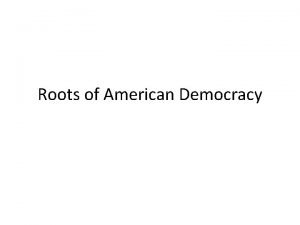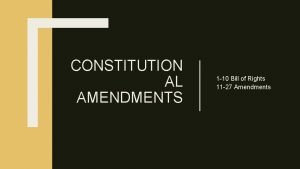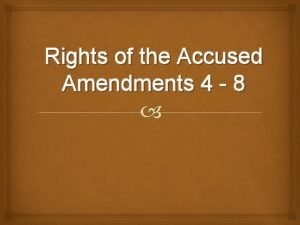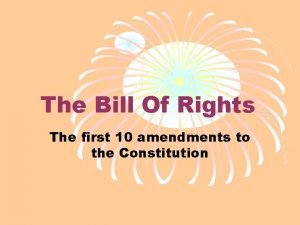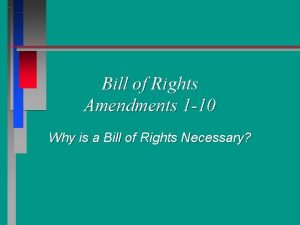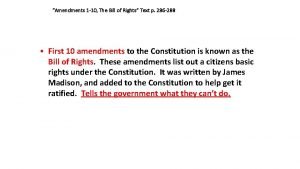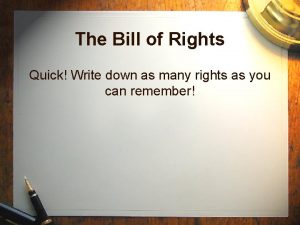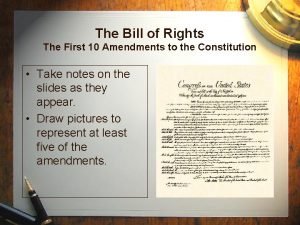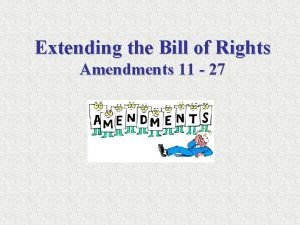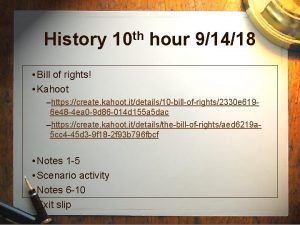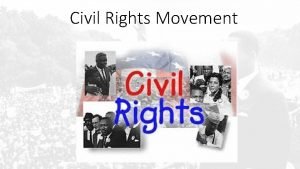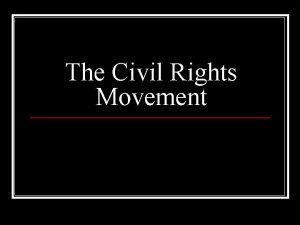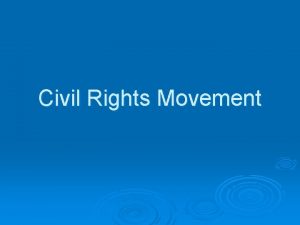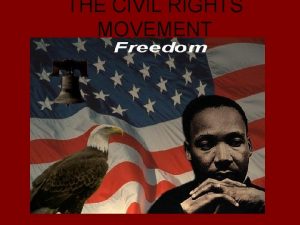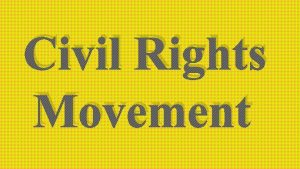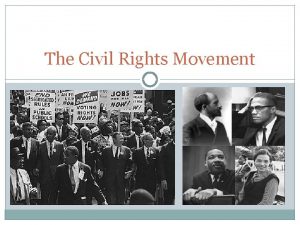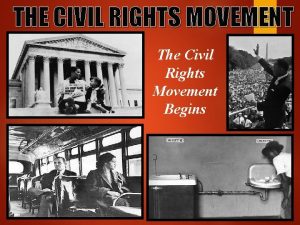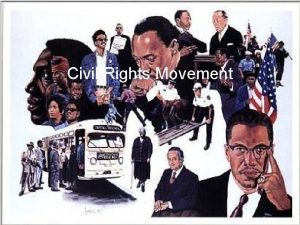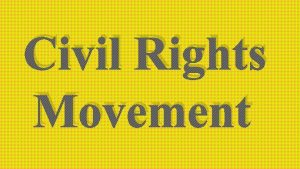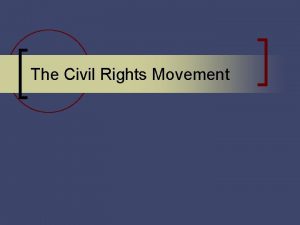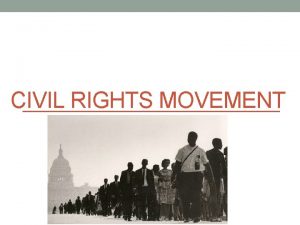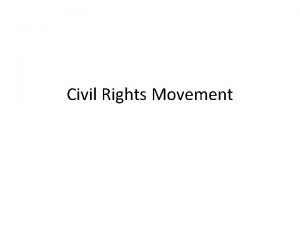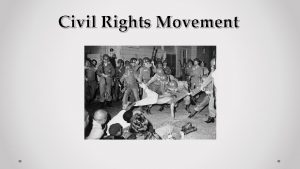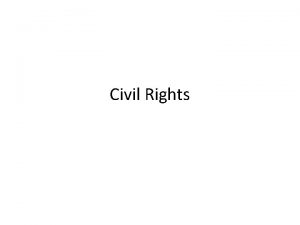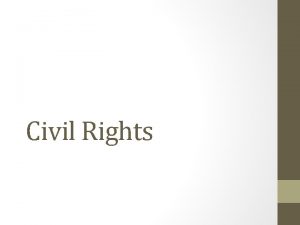CIVIL RIGHTS MOVEMENT Civil War Amendments 13 th





















- Slides: 21

CIVIL RIGHTS MOVEMENT

Civil War Amendments 13 th: 1865 Abolished slavery � 14 th: 1869 Established citizenship � 15 th: 1870 All men could vote � Almost a hundred years later and African Americans were still not given the same rights and freedoms that the Constitution promises. Before the Civil Rights movement, the country was segregated, there were voting restrictions, and many were discriminated against. �

Brown v. Board of Education � Free and Equal Public Education wasn’t always available to everyone. � The journey to equality in education began with a court case called Plessy v. Ferguson in Topeka, KS

Brown v. Board of Education Plessy v. Ferguson � This case began when an African American man was forced to move to the back of a train traveling south. � He sued the train company for requiring him to move to the back based on his skin color � The court ruled that the company could segregate their trained as long as the facilities were equal. � This “Separate but Equal” ruling set the precedent in many other cases and allowed for segregation to continue.

Brown v. Board of Education In 1954, a young girl and her father challenged the Plessy v. Ferguson ruling. � The little girl had to walk miles away to a school for African Americans that was not adequate instead of the nicer school that was close to her house. � The family won the case when the judge declared separate was NOT equal. � This case was a great first step, however, restaurants and stores could sill segregate. It also gave no specific time for school to integrate. �

Montgomery Bus Boycott Rosa Parks In 1955, Rosa Parks was arrested for refusing to move to the back of the bus. � A boycott follows, leading to desegregation. � A boycott is an organized campaign to refuse to buy or use certain goods and services �

The Little Rock Nine � In 1957, President Eisenhower sent federal troops to Central High School in Little Rock, Arkansas after the governor of Arkansas used the National Guard to deny entrance to African-American students.

Greensboro Sit In (1960) Four young African American college freshman staged a nonviolent protest of segregated establishments in North Carolina. � They four students sat down at a lunch counter in an all white establishment in downtown Greensboro � Even though they were denied service, the Greensboro four refused to give up their seats. � Police arrived but were unable to take action because the men were protesting in a non violent manner. Local and national news were called. �

Greensboro Sit In The four stayed until closing and retuned the next day, continuing in their nonviolent manner. More students soon joined the original four. � By the firth day, some 300 students had joined the protest. � Soon these nonviolent movements spread across the south, bringing national attention to segregation in the south. � The all white establishment was forced to integrate- they could not continue to ignore hundreds of men and women �

March on Washington On August 28, 1963, more than 200, 000 Americans gathered in Washington, D. C. to shed light on the political and social challenges African Americans faced. � Dr. Martin Luther King Jr delivered his famous “I have a dream” speech which called for racial justice and equality. �

Civil Rights Act 1964 � John F. Kennedy originally asked for a bill "giving all Americans the right to be served in facilities which are open to the public— hotels, restaurants, theaters, retail stores, and similar establishments, ” in his civil rights speech on June 11 th, 1963.

Civil Rights Act 1964 � The Bill: �Banned racial discrimination in employment �Provided greater protection to black voters �Eliminated segregation in a publically owned facilities (not just schools �Strengthened the anti-segregation clauses regarding public facilities; such as lunch counters �Gave authorization for the Attorney General to file lawsuits to protect individuals against “the deprivation of any rights secured by the Constitution or U. S law. ”

Civil Rights Act 1964 � Issues Getting the Bill Passed: �The bill was moved to the House of Representatives Rules Committee, whose chairman vowed to keep the bill from leaving the committee or passing �President Kennedy, who had been pushing for this bill, was assassinated in November 1963. �President Johnson’s (Kennedy’s VP) first address said that the greatest way to honor President Kennedy would be to pass the Civil Rights Bill

Civil Rights Act 1964 � � � The Bill was passed in the House of Representatives 290 -130 The Bill then moved on to the Senate in March of 1964 where 18 Southern Senators launched a filibuster to prevent the bill from passing Filibuster: a prolonged speech that prevents a bill becoming a law. The filibuster lasted for 54 days On June 19, 1964, the Senate Voted to pass the Bill 71 -29 President Johnson signed it into law on July 2, 1964

March at Selma � 1965 Dr. Martin Luther King Jr launched a protest about African Americans right to vote in Selma, Alabama �He believed the right to vote without fear or difficulty was vital if civil rights were to be won �Voter registration qualifications in the South often made it impossible for Blacks to vote � Why Selma? �In Selma only 324 out of 15, 000 African Americans were registered to vote. (Those who attempted to register were prevented) �Governor of Alabama, George Wallace promised “Segregation forever!”

March at Selma �A month before the planned march, Dr. King deliberately got himself arrested. �He recently won the Nobel Peace Prize and his arrest would bring publicity to their cause.

March at Selma � � � The March began on March 7, 1965 and the goal was to march from Selma to Birmingham. 600 marchers were met by 200 state troopers and local police armed with tear gas, sticks, and whips. When the marchers refused to turn back they were attacked. 17 marchers were hospitalized March 21 st the march began again and this time were protected by U. S. troops. The marchers reached Birmingham March 25 th.

Voting Rights Act 1965 � August 1965 Congress passed the Voting Rights Act �This act removed various barriers to voting registrations Within three years most of the African American population of the South were registered to vote � White politicians need African American votes to stay in power � Some African Americas saw this as an opportunity to become politicians themselves �

Voting Rights Act 1965

Martin Luther King Jr. ’s Assassination

Dr. Martin Luther King Jr. ’s Assassination � � � In the spring of 1968, Dr. King was in Memphis, TN to support the sanitation workers’ strike. On April 3, 1968, King was standing on the secondfloor balcony of the hotel where he was staying, when he was fatally hit by a sniper bullet. Shock and distress over the news of King’s death sparked violent rioting in more than 100 cities around the country. President Johnson urged Americans to stop the violence because King believed strongly in the nonviolent movement. He also urged congress to pass the Civil Rights Act of 1968 as a legacy to Dr. King. The Act, also known as the Fair Housing Act was passed.
 Civil rights and civil liberties webquest
Civil rights and civil liberties webquest Civil rights movement vocabulary
Civil rights movement vocabulary Rosa parks mother
Rosa parks mother Civil rights movement webquest
Civil rights movement webquest Civil rights movement jeopardy
Civil rights movement jeopardy The civil rights movement
The civil rights movement Civil rights movement goal
Civil rights movement goal Civil rights movement essential questions
Civil rights movement essential questions 10 amendments bill of rights
10 amendments bill of rights Amendments 1-10
Amendments 1-10 Amendments 4-8
Amendments 4-8 Bill of rights 10 amendments
Bill of rights 10 amendments 1-10 amendments
1-10 amendments 1-10 amendments
1-10 amendments Bill of rights 10 amendments
Bill of rights 10 amendments What are the 10 amendments
What are the 10 amendments Amendments 11 27
Amendments 11 27 What is the 9 amendment in simple terms
What is the 9 amendment in simple terms Why was the civil war considered the first modern war
Why was the civil war considered the first modern war Chapter 16 lesson 2 challenges to slavery
Chapter 16 lesson 2 challenges to slavery Legal rights and moral rights
Legal rights and moral rights Positive rights and negative rights
Positive rights and negative rights



